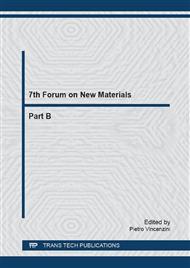p.44
p.54
p.64
p.70
p.75
p.82
p.93
p.103
p.109
Characterization of Lead Lanthanum Zirconate Titanate Ceramics Co-Doped with Lanthanide Ions
Abstract:
The aim of this work was to obtain Pb0.92(La0.08)(Zr0.65Ti0.35)0.98O3 materials co-doped with two different lanthanide ions (Ln3+) and characterization how they influence on the physical properties of prepared 8/65/35 PLZT: Ln3+ ceramics. As a co-dopant, praseodymium (Pr3+) and neodymium (Nd3+) ions were used at the concentration of 0.0 and 0.5 wt.% respectively. The ceramic powders of 8/65/35 PLZT, PLZT:Pr3+ as well PLZT:Nd3+ were synthesized by conventional ceramic route, from high purity raw oxide materials (>99,9%). All compositions of the ceramic samples were sintered via single time process at Ts=1200°C/3h, by the hot uniaxial pressing method. Performed measurements have shown dependence of used dopant on structure, microstructure, and dielectric as well optical properties of the fabricated 8/65/35 PLZT: Ln3+ materials.
Info:
Periodical:
Pages:
75-81
Citation:
Online since:
October 2016
Authors:
Keywords:
Price:
Сopyright:
© 2017 Trans Tech Publications Ltd. All Rights Reserved
Share:
Citation:


